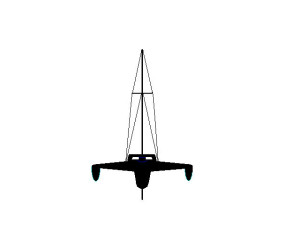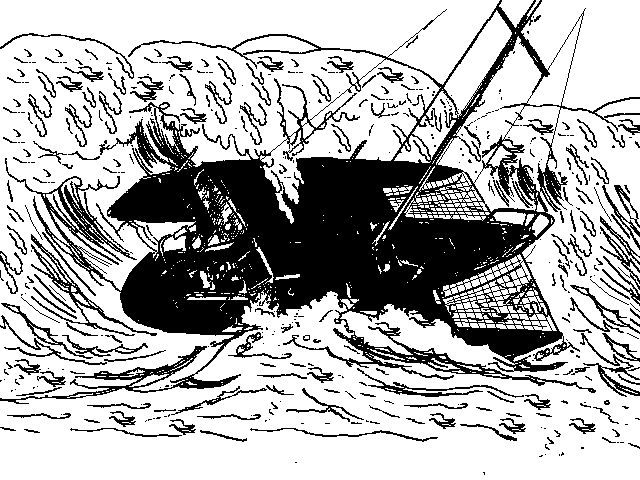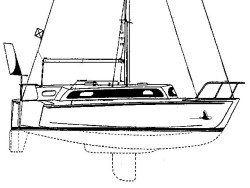S/T-18
Trimaran, Searunner
40' x 24' x 7.5 Tons
28-Ft. Dia. Parachute Sea Anchor
Force 10 Conditions
File S/T-18, obtained from Steve and Cheryl Bow, Auckland NZ. - Vessel name Labyrinth, hailing port Auckland, Searunner trimaran designed by Jim Brown, LOA 40' 10" x Beam 23' 6" x Draft 6' 11" (3' 6" board up) x 7.5 Tons - Sea anchor: 28-ft. Diameter Australian army cargo parachute on 400' x 3/4" nylon three strand tether and bridle arms of 90' each, with 5/8" galvanized swivel - Partial trip-line - Deployed in a storm in deep water about 270 miles south of Kermadec Islands with winds of 50-60 knots and seas of 30-35 ft. - Vessel's bow yawed 10° - Drift was 6.2 n.m. during 41 hours at sea anchor.
Steve and Cheryl Bow cruised the world aboard their 40-ft. Searunner Labyrinth. On 15 June 1995 (a year after the Queen's Birthday storm) they left Auckland and headed north for Tonga. Two days later they ran into a Force-10 storm about 270 miles south of the Kermadecs. Transcript:
We are a two-handed husband and wife crew. It was our plan to leave NZ on the back of a low that was at that time centered near Mt. Taranaki. Following it was a huge high over Australia and the winds between the two promised fair sailing. No fronts or depressions were forecast or expected from the coming weather. Our first days run was a rolly 155 miles broad reach in a 30 knot SW breeze and we were feeling very happy about things until we discovered water in the bilge at 2200 hrs on the 16th June. A porthole under the wingdeck had blown in and was leaking considerably. We effected a temporary repair and that took us through to daybreak.
At 0800 hrs we changed course and ran off before the wind for 6 hours while I epoxied the portholes closed with underwater epoxy. While we were running off, the latest weatherfax showed that a rapidly deepening low had formed north of Sydney and was heading our way - fast. If we hadn't had to run off to make the repairs we would have been OK, but as it was we were right in its path. Knowing that we were in for a rough night I went to bed, leaving Cheryl to do a long watch so that I would be fresh for the evening. When I awoke at 1800 hrs the winds were gusting over 30 knots from the NE and Cheryl had hove-to. We had two reefs in the main and the stays'l set; at this point the boat was comfortable despite the worsening seas and we settled down to sit it out. The 2000 hrs fax showed a second rapidly deepening low had formed behind the first.
Between 1400 and 1930 hrs the barometer dropped from 1005 bar to 998 bar. When the winds reached 50 knots and the barometer was still dropping we had to make the decision - run off, or set the parachute. It was 1930 hrs and very dark, we could see the approaching seas only by the foam as they broke, and the spray was being driven horizontally by the wind. The seas were still building and had reached the unstable stage, with steep faces and rolling crests. We carry a SEABRAKE on board which was set up ready to go, however we opted to set the parachute for two reasons: 1) We were both very tired and probably not up to spending a considerable time helming a running yacht in steep seas; and 2) The NE wind would have been driving us back towards the North Island of NZ. With further depressions developing and no early respite expected, the parachute was selected as the better option.
We set the parachute. We had never set it before, however I had read all the information I could acquire and had watched the video prepared by Para-Tech. It had been assembled as per their instructions, complete with one of their deployable storage bags. It was deployed over the weather bow while still hove-to, and worked like a charm. It was gusting 60 knots and more by the time we had it set, and it was difficult to see or work on deck because of the driven spray. As the tension went onto the tether we were swung gently around bow to and then sat there. The hard part was getting the stays'l and main down and under control in the high winds. The centerboard had already been pulled up.
At 2400 hrs the barometer had dropped to 993 bar and the wind speed was rarely below 60 knots. The motion of the boat was good, just a steady rise and fall to the waves with an occasional loud BANG! as a cross swell broke against the hulls. Despite my previous fears of excessive strain on the yacht the bows were NEVER pulled through any of the breaking crests, instead rising up and over them. There was tremendous strain on the bridle and tether, which "hummed" at times. Despite the noise the motion was easy enough for us to get sleep and cook between watches.
Waves continued to break on either side of the yacht, but we appeared to sit in a "slick" behind the parachute where there was only foam. We rigged nylon chafe protection on the bridle near exposed metalwork on the yacht and I checked for chafe every hour, both there and at the snatchblocks on the bows. At the end of 41 hours we still did not have any chafe. A mistake I made was in relying on the hydraulic steering ram to hold the rudder amidships. The force on the rudder from cross swells and rogue waves was substantial enough to drive the hydraulic ram to the end of its travel, and the rudder hard over. This was cured by shackling sheets [ropes] direct to the rudder and winching/cleating it off amidships.
We sat to the parachute for 41 hours; the wind went up and down averaging 45 knots and sometimes dropping below 30 knots. At 1230 hrs on the 19th June the wind was still 30 knots but had backed to NW. We opted to pull up the parachute and make a run for it north to try and get above the depressions. All went well retrieving the chute except that just as I was about to pull it in over the side of the boat the retrieval line ripped off the apex of the parachute and the chute filled again! We were drifting broadsides at the time and making quite a bit of way. I nearly got pulled over the side and lost most of the skin off my hands while trying to re-cleat the tether. This could not have happened with a purpose-built sea anchor! A 28 ft diameter parachute is almost impossible to retrieve in those conditions with no retrieval line and only two crew. We tried for over two hours and in the end I had to cut it free.
If we had known what we would face for the next 48 hours we would have stayed on the chute. We started off hard-on into the wind which was averaging 25-30 knots. This became a tight reach as it was more comfortable. Seas were rough and confused and repeatedly broke against the hulls.... Each time we hit one we would stop dead in our tracks. The noise was incredible and with the front of the boat continually getting swept by the seas I was worried that something would get broken if we didn't slow down (it turned out that we did break a stringer in the forward section of the stbd float).
On 21st of June we finally ran out of the weather. Incredibly a fourth low had formed and taken the same path as the other three, but by this time we had climbed out above it. We would never put to sea for an ocean passage again without a parachute.
Love the Drag Device Database? Help us to keep it free for all mariners by making a tiny donation to cover our server and maintenance costs. Thank You!





